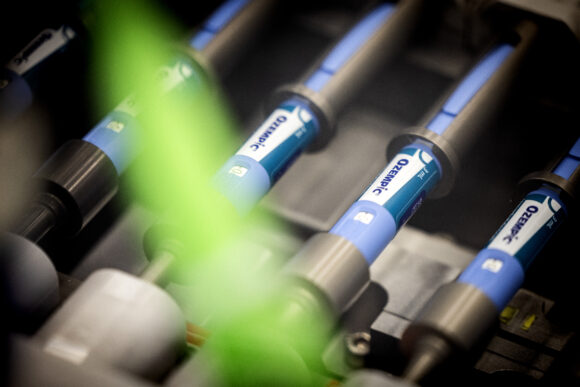Four patients who developed a serious eye disease after using Novo Nordisk A/S’s blockbuster weight-loss drugs have been granted compensation in Denmark, the drugmaker’s home market.
The claimants received a combined 800,000 kroner ($124,000), though that figure may rise if further loss of earnings is proven, according to Danish Patient Compensation, an independent association financed by the state and insurers.
So far, the body said it has received 43 claims from patients who believe they developed the condition known as NAION after taking Wegovy or Ozempic. The agency has ruled on five cases, granting compensation in four and rejecting one. It said eligibility depends on individual assessments and that not all cases automatically qualify for compensation.
NAION occurs when a loss of blood flow damages the optic nerve, and is most common in people over the age of 50. Though rare, the eye condition is irreversible, untreatable and potentially blinding, and doctors have said that patients should be informed of a possible risk.
“It’s unfortunate for the patients affected by this side effect,” Karen-Inger Bast, managing director of the association, said in a statement. “NAION is a serious disease that causes permanent and incurable damage to vision.”
Novo has reviewed the ruling and takes all reports of adverse events related to the use of its medicines “very seriously,” a spokesperson said by email. The drugmaker has already updated patient leaflets in the EU for its marketed semaglutide products to include NAION as a “very rare adverse drug reaction,” though Novo believes the “benefit-risk profile of semaglutide remains favorable.”
Earlier this year, the European Medicines Agency’s safety committee found that NAION is a very rare side effect of semaglutide, a key ingredient in diabetes and obesity drugs. It could affect as many as 1 in 10,000 people taking the medicines, it said, adding that product labels should be updated to reflect that risk.
The EMA’s review came after the Danish Medicines Agency asked it to look at two studies — conducted independently — that found that people with type 2 diabetes who took Ozempic faced more than twice the risk of developing the eye condition.
The semaglutide link to NAION was first suggested in 2024 in a Harvard University study.
Photograph: Ozempic injection pens; photo credit: Carsten Snejbjerg/Bloomberg
Was this article valuable?
Here are more articles you may enjoy.



 PwC: Insurance Execs Say Agentic AI Leading Industry Transformation
PwC: Insurance Execs Say Agentic AI Leading Industry Transformation  Ex-Lloyd’s CEO Lost $17 Million AIG Job After Office Romance
Ex-Lloyd’s CEO Lost $17 Million AIG Job After Office Romance  Insurance IPOs Hit 20-Year High on Wall Street
Insurance IPOs Hit 20-Year High on Wall Street  NFIP Reauthorized With Passage of Funding Bill to End Government Shutdown
NFIP Reauthorized With Passage of Funding Bill to End Government Shutdown 

